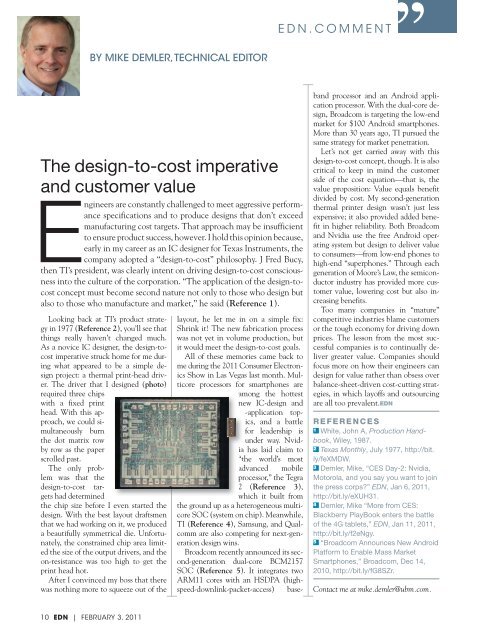VOICE OF THE ENGINEER - ElectronicsAndBooks
VOICE OF THE ENGINEER - ElectronicsAndBooks
VOICE OF THE ENGINEER - ElectronicsAndBooks
- No tags were found...
You also want an ePaper? Increase the reach of your titles
YUMPU automatically turns print PDFs into web optimized ePapers that Google loves.
EDN.COMMENTBY MIKE DEMLER, TECHNICAL EDITORThe design-to-cost imperativeand customer valueEngineers are constantly challenged to meet aggressive performancespecifications and to produce designs that don’t exceedmanufacturing cost targets. That approach may be insufficientto ensure product success, however. I hold this opinion because,early in my career as an IC designer for Texas Instruments, thecompany adopted a “design-to-cost” philosophy. J Fred Bucy,then TI’s president, was clearly intent on driving design-to-cost consciousnessinto the culture of the corporation. “The application of the design-tocostconcept must become second nature not only to those who design butalso to those who manufacture and market,” he said (Reference 1).Looking back at TI’s product strategyin 1977 (Reference 2), you’ll see thatthings really haven’t changed much.As a novice IC designer, the design-tocostimperative struck home for me duringwhat appeared to be a simple designproject: a thermal print-head driver.The driver that I designed (photo)required three chipswith a fixed printhead. With this approach,we could simultaneouslyburnthe dot matrix rowby row as the paperscrolled past.The only problemwas that thedesign-to-cost targetshad determinedthe chip size before I even started thedesign. With the best layout draftsmenthat we had working on it, we produceda beautifully symmetrical die. Unfortunately,the constrained chip area limitedthe size of the output drivers, and theon-resistance was too high to get theprint head hot.After I convinced my boss that therewas nothing more to squeeze out of thelayout, he let me in on a simple fix:Shrink it! The new fabrication processwas not yet in volume production, butit would meet the design-to-cost goals.All of these memories came back tome during the 2011 Consumer ElectronicsShow in Las Vegas last month. Multicoreprocessors for smartphones areamong the hottestnew IC-design and-application topics,and a battlefor leadership isunder way. Nvid-ia has laid claim to“the world’s mostadvancedmobileprocessor,” the Tegra2 (Reference 3),which it built fromthe ground up as a heterogeneous multicoreSOC (system on chip). Meanwhile,TI (Reference 4), Samsung, and Qualcommare also competing for next-generationdesign wins.Broadcom recently announced its second-generationdual-core BCM2157SOC (Reference 5). It integrates twoARM11 cores with an HSDPA (highspeed-downlink-packet-access)basebandprocessor and an Android applicationprocessor. With the dual-core design,Broadcom is targeting the low-endmarket for $100 Android smartphones.More than 30 years ago, TI pursued thesame strategy for market penetration.Let’s not get carried away with thisdesign-to-cost concept, though. It is alsocritical to keep in mind the customerside of the cost equation—that is, thevalue proposition: Value equals benefitdivided by cost. My second-generationthermal printer design wasn’t just lessexpensive; it also provided added benefitin higher reliability. Both Broadcomand Nvidia use the free Android operatingsystem but design to deliver valueto consumers—from low-end phones tohigh-end “superphones.” Through eachgeneration of Moore’s Law, the semiconductorindustry has provided more customervalue, lowering cost but also increasingbenefits.Too many companies in “mature”competitive industries blame customersor the tough economy for driving downprices. The lesson from the most successfulcompanies is to continually delivergreater value. Companies shouldfocus more on how their engineers candesign for value rather than obsess overbalance-sheet-driven cost-cutting strategies,in which layoffs and outsourcingare all too prevalent.EDNREFERENCES1 White, John A, Production Handbook,Wiley, 1987.2 Texas Monthly, July 1977, http://bit.ly/feXMDW.3 Demler, Mike, “CES Day-2: Nvidia,Motorola, and you say you want to jointhe press corps?” EDN, Jan 6, 2011,http://bit.ly/eXUH31.4 Demler, Mike “More from CES:Blackberry PlayBook enters the battleof the 4G tablets,” EDN, Jan 11, 2011,http://bit.ly/f2eNgy.5 “Broadcom Announces New AndroidPlatform to Enable Mass MarketSmartphones,” Broadcom, Dec 14,2010, http://bit.ly/fG8SZr.Contact me at mike.demler@ubm.com.10 EDN | FEBRUARY 3, 2011






![[270].pdf 37407KB Sep 02 2010 09:55:57 AM - ElectronicsAndBooks](https://img.yumpu.com/50350834/1/185x260/270pdf-37407kb-sep-02-2010-095557-am-electronicsandbooks.jpg?quality=85)
![draaien, A Viruly 1935 OCR c20130324 [320]. - ElectronicsAndBooks](https://img.yumpu.com/49957773/1/190x252/draaien-a-viruly-1935-ocr-c20130324-320-electronicsandbooks.jpg?quality=85)



![20051110 c20051031 [105].pdf 35001KB Feb 18 2009 08:46:32 PM](https://img.yumpu.com/48687202/1/190x253/20051110-c20051031-105pdf-35001kb-feb-18-2009-084632-pm.jpg?quality=85)




